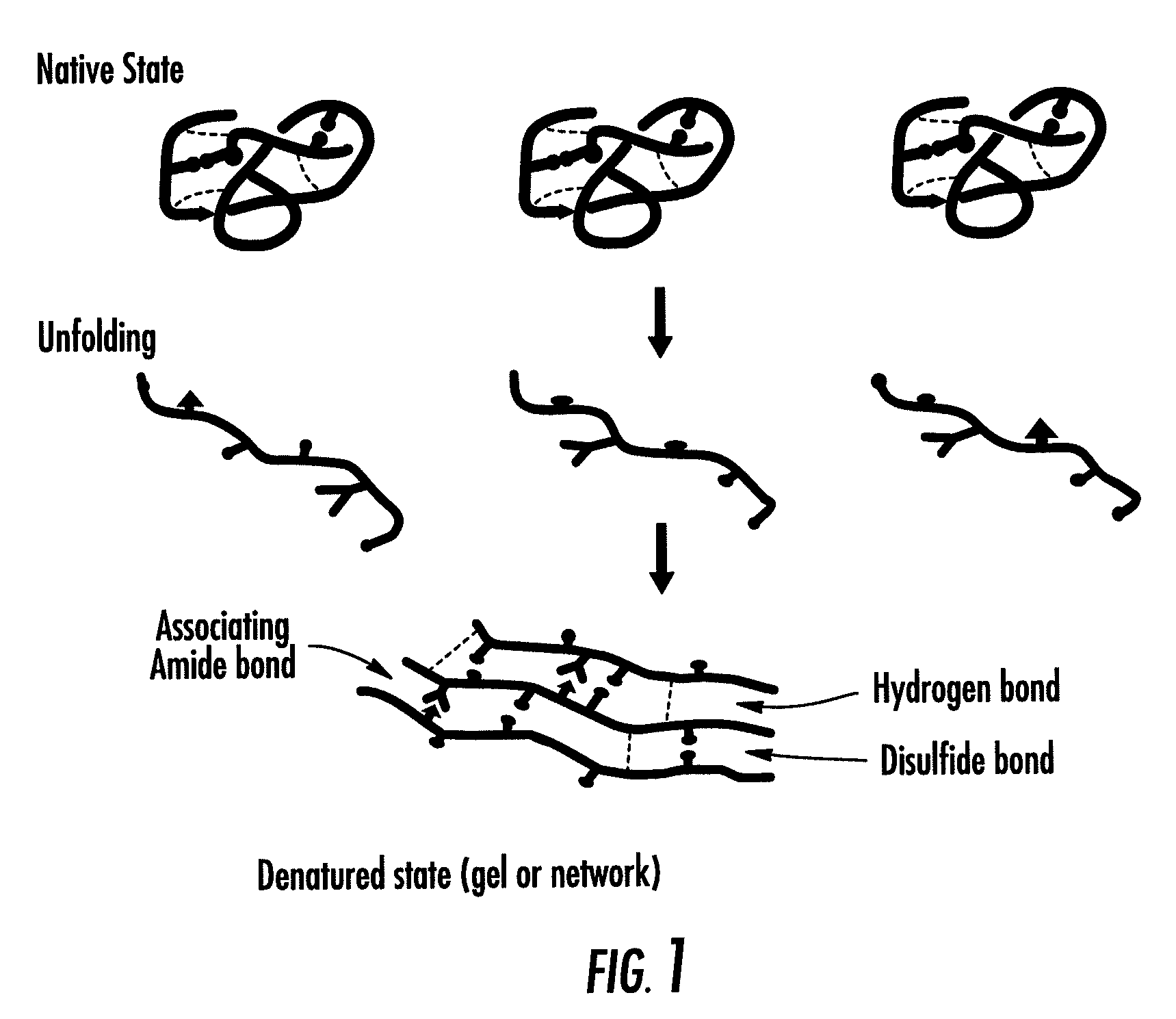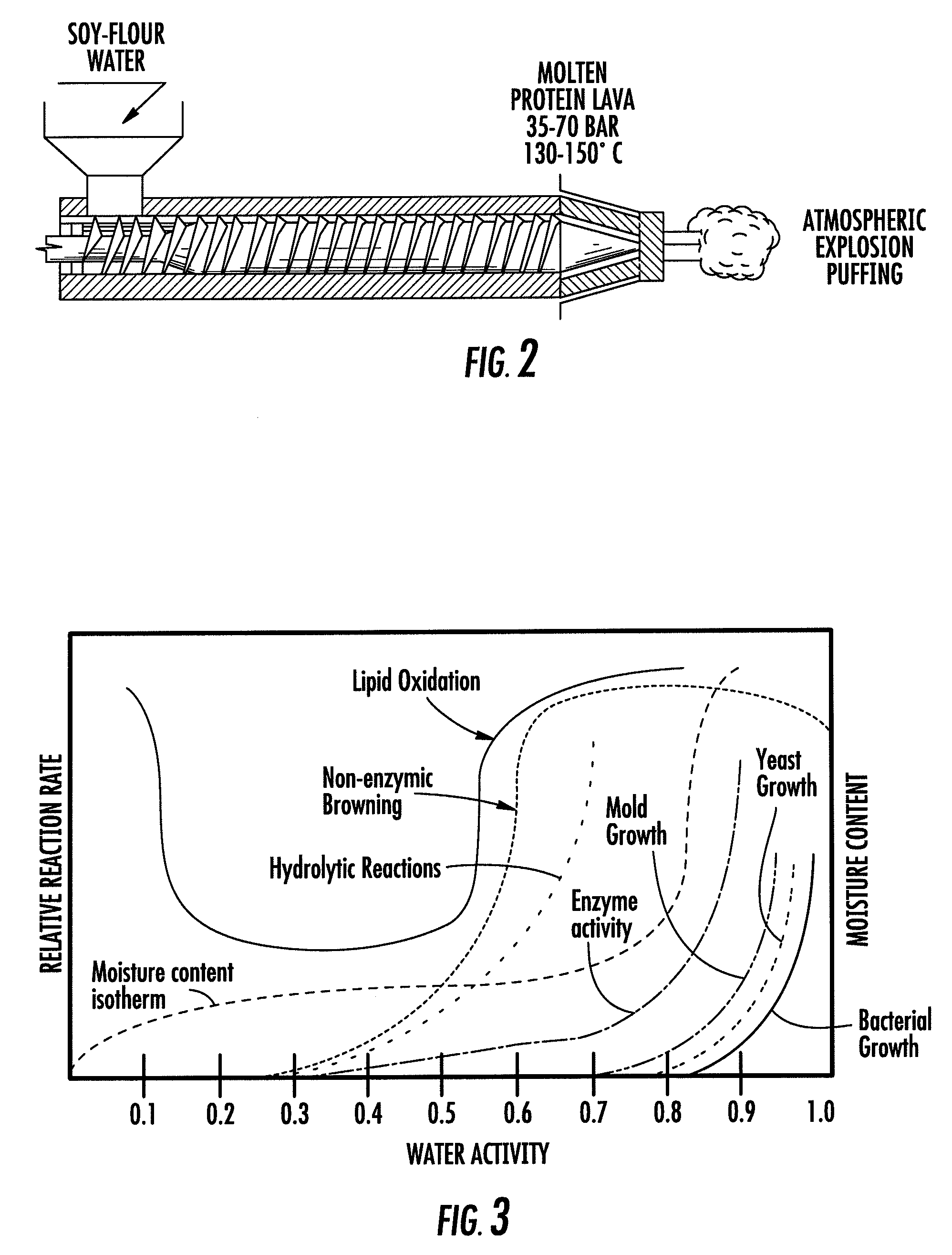Low temperature forming of feeds
a feed and low temperature technology, applied in the field of low temperature forming of feeds, can solve the problems of increased temperature, increased friction, and high pressure within the barrel, and achieve the effect of reducing the application of moisture, heat and/or pressure, and ensuring the binding and holding of other ingredients
- Summary
- Abstract
- Description
- Claims
- Application Information
AI Technical Summary
Benefits of technology
Problems solved by technology
Method used
Image
Examples
example 1
High Moisture Extrusion Cooking (HMEC)
[0105]General Information[0106]The preparation of Meat Analogues and Seafood Extenders via the process known as High Moisture Extrusion Cooking (HMEC) is becoming more popular as a means of better utilizing lower grade raw material sources for both Human Consumption and also in Premium Pet Food applications.[0107]At High Moisture Contents (>50% w / w), Viscous Dissipation is minimized due to the low Melt Viscosity. The Temperature Rise is therefore, most significantly influenced by the Conductive Heat Transfer.[0108]Typical composition of the Defatted Soy Flour (DSF)
Protein55% to 65%Nitrogen Solubility Index30%Fat3% to 5%Moisture 8% to 10%Ash4% to 6%[0109]DSF (at 60% w / w moisture content) will melt at T=130° C. It is typical to target a Melt Moisture Content in the range of 55[0110]The (uniform) Melt Temperature above 130° C. is a critical parameter for the protein cross-linking reaction. The Tensile Strength of products will increase as the melt ...
example 2
Textured Vegetable Protein (TVP)
[0141]General Information[0142]The processing of various Vegetable Protein sources (Soya, Wheat Gluten and other sources such as Peanut and Extracted Oil Seed) via Extrusion Technology results in the enhancement of the digestibility of the raw material, as well as an improvement in the palatability of the product.[0143]A typical formulation for a TVP for use in a Dry Pet Food application is presented below
%Meat / Poultry By-Product4.0Defatted Soy Flour50.0Whole Wheat42.5Pigment0.03Vitamins / Minerals3.5Total100.0%[0144]When assessing the suitability of a given Protein Source for use in the Extrusion Process, the following points should be taken into account:[0145]The Total Protein Content[0146]The Total Fat Content[0147]The Protein Solubility in Water, which is related to the degree of Thermal Damage experience during processing. (This is most readily measured via the Protein Dispersibility Index, PDI or the Nitrogen Solubility Index, NSI)[0148]The Total ...
example 3
Starch-based Canine Feed
[0171]A recipe for low-temperature formed starch based pellets used as canine feed:
[0172]Dry pre gelatinized starch base as described above—40%
[0173]Grains or grain components as described above—15%
[0174]Meat meals or Meat and Bone meals as described above—40%
[0175]Meat digest, tallow—5%.
[0176]It will be recognized by persons skilled in the art that numerous variations and modifications may be made to the invention as broadly described and exemplified herein without departing from the spirit and scope of the invention.
TABLE 1Typical Pet Food Product FormulationInclusionLevelIngredient(% w / w)Functional Protein (from Vital Wheat Gluten, Defatted Soy25-55Flour, Soy Protein Concentrate, Soy Protein Isolate,Corn Gluten Meal, Mung Beans or Yeast By-products)Grain Flour (from Wheat, Corn or Rice)10-25Meat / Poultry / Fish By-Product Meals15-25Sugar 5-10Glycerol4-8Vegetable Oil3-6Potasium Sorbate0.5-1.5Digest (Palatability Enhancer)2-4
PUM
 Login to View More
Login to View More Abstract
Description
Claims
Application Information
 Login to View More
Login to View More - R&D
- Intellectual Property
- Life Sciences
- Materials
- Tech Scout
- Unparalleled Data Quality
- Higher Quality Content
- 60% Fewer Hallucinations
Browse by: Latest US Patents, China's latest patents, Technical Efficacy Thesaurus, Application Domain, Technology Topic, Popular Technical Reports.
© 2025 PatSnap. All rights reserved.Legal|Privacy policy|Modern Slavery Act Transparency Statement|Sitemap|About US| Contact US: help@patsnap.com



